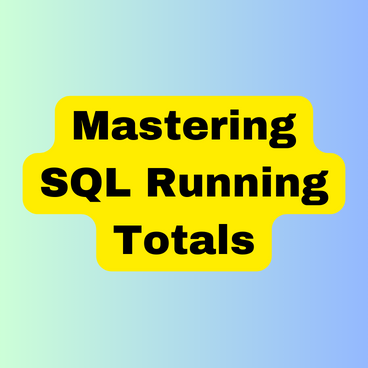What Is a SQL Running Total and How Do You Compute It?
Data analysis often involves calculating cumulative or running totals, which provide valuable insights into the progression of data over time. In SQL, you can efficiently compute running totals using the appropriate window functions. In this blog, we'll explore what a SQL running total is, how to compute it using T-SQL 2012, its advantages, disadvantages, use cases, and best practices, using a sample product sales dataset.
Understanding the Sample Dataset
Let's start by looking at a simplified product sales dataset:
| productid | productname | supplierid | categoryid | unitprice | discontinued |
|-------------|----------------------|-------------|---------------|------------|--------------|
| 1 | Product HHYDP | 1 | 1 | 18.00 | 0 |
| 2 | Product RECZE | 1 | 1 | 19.00 | 0 |
| 3 | Product IMEHJ | 1 | 2 | 10.00 | 0 |
| 4 | Product KSBRM | 2 | 2 | 22.00 | 0 |
| 5 | Product EPEIM | 2 | 2 | 21.35 | 1 |
| 6 | Product VAIIV | 3 | 2 | 25.00 | 0 |
| 7 | Product HMLNI | 3 | 7 | 30.00 | 0 |
| 8 | Product WVJFP | 3 | 2 | 40.00 | 0 |
| 9 | Product AOZBW | 4 | 6 | 97.00 | 1 |
| 10 | Product YHXGE | 4 | 8 | 31.00 | 0 |
Computing a Running Total
To calculate a running total of the `unitprice` column, you can use the `SUM` window function. Here's the T-SQL code for it:
SELECT
productid,
productname,
unitprice,
SUM(unitprice) OVER (ORDER BY productid) AS running_total
FROM production.products
In this query:
- `SELECT` specifies the columns to include in the result set.
- `productid`, `productname`, and `unitprice` are selected for display in the output.
- `SUM(unitprice) OVER (ORDER BY productid)` calculates the running total of `unitprice`. The `SUM` function is applied over the window defined by `ORDER BY productid`, which orders the data by the `productid` column.
Advantages and Disadvantages
Advantages:
1. Insight into Progression: Running totals provide a clear picture of how a value accumulates or progresses over a dataset, which is valuable for understanding trends.
2. Data Analysis: They are often used in financial, sales, and inventory analysis to track cumulative totals over time.
3. Ease of Calculation: With SQL window functions like `SUM`, computing running totals is straightforward and efficient.
Disadvantages:
1. Performance: Calculating running totals over large datasets can be computationally intensive and may impact query performance.
2. Real-time Updates: Running totals can be challenging to maintain in real-time as new data is added to the dataset.
Use Cases
- Sales Analysis: Tracking cumulative sales revenue to assess performance.
- Inventory Management: Monitoring the total quantity of items in stock.
- Financial Statements: Preparing financial statements with running totals for revenue, expenses, and profits.
- Time-Series Data: Analyzing time-series data like stock prices, weather data, or website traffic.
Best Practices
- Use appropriate indexing and partitioning to improve query performance.
- Consider data warehousing solutions for large-scale running total calculations.
- Document your code for clarity and future reference.
Conclusion
Understanding and computing SQL running totals is a valuable skill for data analysts and SQL developers. By applying window functions like `SUM`, you can gain insights into data progression, helping you make informed decisions in various domains. However, be mindful of performance considerations when working with large datasets, and follow best practices to ensure efficiency and accuracy in your calculations.



.png)




.png)
.jpg)
.png)


.png)
